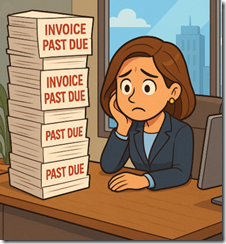Complexity: Good Enough Is Now the Best Some Can Do at Google-
May 15, 2025
![dino-orange_thumb_thumb_thumb_thumb_[1]_thumb_thumb dino-orange_thumb_thumb_thumb_thumb_[1]_thumb_thumb](https://www.arnoldit.com/wordpress/wp-content/uploads/2025/05/dino-orange_thumb_thumb_thumb_thumb_1_thumb_thumb_thumb.gif) No AI, just the dinobaby expressing his opinions to Zillennials.
No AI, just the dinobaby expressing his opinions to Zillennials.
I read a post called “Working on Complex Systems: What I Learned Working at Google.” The write up is a thoughtful checklist of insights, lessons, and Gregorian engineering chants a “coder” learned in the online advertising company. I want to point out that I admire the amount of money and power the Google has amassed from its reinvention of the GoTo-Overture-Yahoo advertising approach.
A Silicon Valley executive looks at past due invoices. The government has ordered the company to be broken up and levied large fines for improper behavior in the marketplace. Thanks, ChatGPT. Definitely good enough.
The essay in The Coder Cafe presents an engineer’s learnings after Google began to develop products and services tangential to search hegemony, selling ads, and shaping information flows.
The approach is to differentiate complexity from complicated systems. What is interesting about the checklists is that one hearkens back to the way Google used to work in the Backrub and early pre-advertising days at Google. Let’s focus on complex because that illuminates where Google wants to direct its business, its professionals, its users, and the pesky thicket of regulators who bedevil the Google 24×7.
Here’s the list of characteristics of complex systems. Keep in mind that “systems” means software, programming, algorithms, and the gizmos required to make the non-fungible work, mostly.
- Emergent behavior
- Delayed consequences
- Optimization (local optimization versus global optimization)
- Hysteresis (I think this is cultural momentum or path dependent actions)
- Nonlinearity
Each of these is a study area for people at the Santa Fe Institute. I have on my desk a copy of The Origins of Order: Self-Organization and Selection in Evolution and the shorter Reinventing the Sacred, both by Stuart A. Kauffman. As a point of reference Origins is 700 pages and Reinventing about 300. Each of the cited articles five topics gets attention.
The context of emergent behavior in human- and probably some machine- created code is that it is capable of producing “complex systems.” Dr. Kauffman does a very good job of demonstrating how quite simple methods yield emergent behavior. Instead of a mess or a nice tidy solution, there is considerable activity at the boundaries of complexity and stability. Emergence seems to be associated with these boundary conditions: A little bit of chaos, a little bit of stability.
The other four items in the list are optimization. Dr. Kauffman points out is a consequence of the simple decisions which take place in the micro and macroscopic world. Non-linearity is a feature of emergent systems. The long-term consequences of certain emergent behavior can be difficult to predict. Finally, the notion of momentum keeps some actions or reactions in place through time units.
What the essay reveals, in my opinion, that:
- Google’s work environment is positioned as a fundamental force. Dr. Kauffman and his colleagues at the Santa Fe Institute may find some similarities between the Google and the mathematical world at the research institute. Google wants to be the prime mover; the Santa Fe Institute wants to understand, explain, and make useful its work.
- The lingo of the cited essay suggests that Google is anchored in the boundary between chaos and order. Thus, Google’s activities are in effect trials and errors intended to allow Google to adapt and survive in its environment. In short, Google is a fundamental force.
- The “leadership” of Google does not lead; leadership is given over to the rules or laws of emergence as described by Dr. Kauffman and his colleagues at the Santa Fe Institute.
Net net: Google cannot produce good products. Google can try to emulate emergence, but it has to find a way to compress time to allow many more variants. Hopefully one of those variants with be good enough for the company to survive. Google understands the probability functions that drive emergence. After two decades of product launches and product failures, the company remains firmly anchored in two chunks of bedrock:
First, the company borrows or buys. Google does not innovate. Whether the CLEVER method, the billion dollar Yahoo inspiration for ads, or YouTube, Bell Labs and Thomas Edison are not part of the Google momentum. Advertising is.
Second, Google’s current management team is betting that emergence will work at Google. The question is, “Will it?”
I am not sure bright people like those who work at Google can identify the winners from an emergent approach and then create the environment for those winners to thrive, grow, and create more winners. Gluing cheese to pizza and ramping up marketing for Google’s leadership in fields ranging from quantum computing to smart software is now just good enough. One final question: “What happens if the advertising money pipeline gets cut off?”
Stephen E Arnold, May 15, 2025



